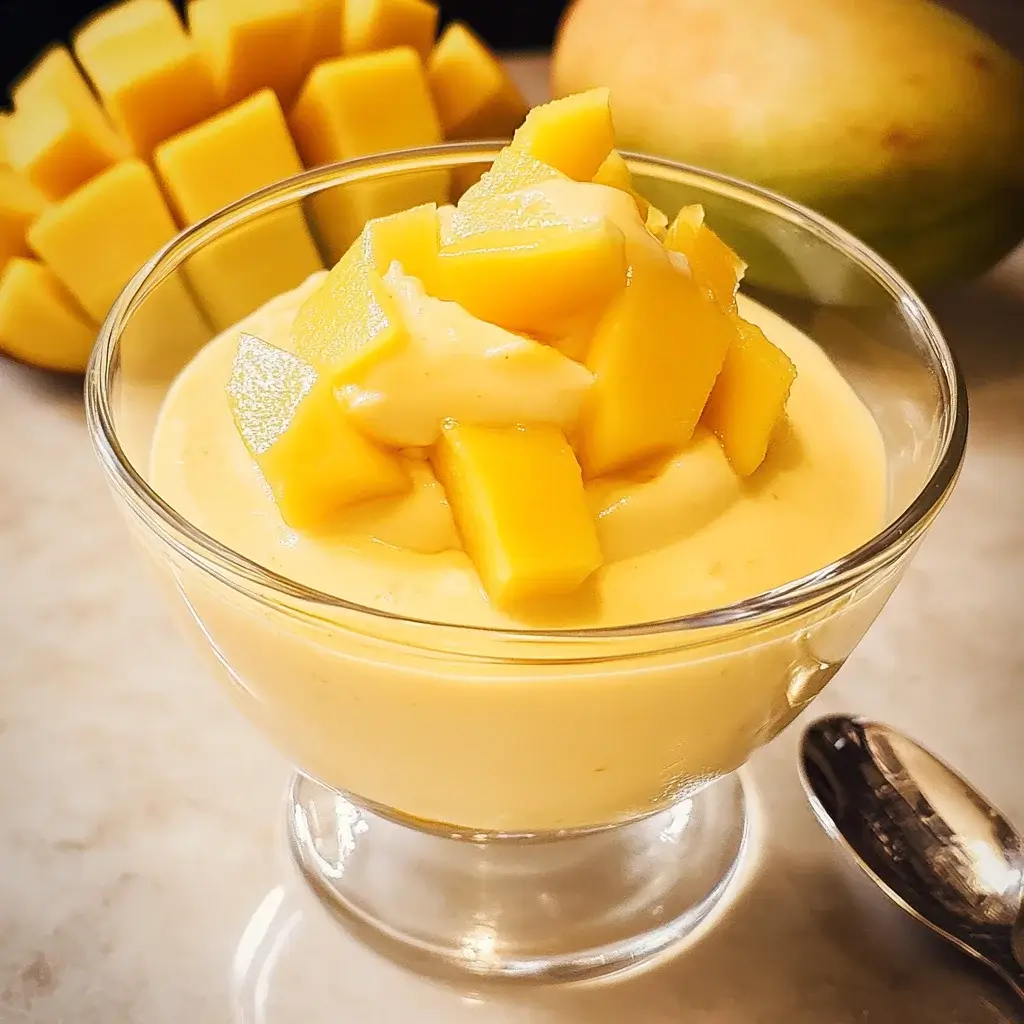There are some desserts that just instantly transport you to a sunny, tropical paradise, and this Creamy Mango Mousse is definitively one of them. The first time I made this, it was for a family barbecue on a sweltering summer afternoon. I was looking for something light, refreshing, and universally appealing, yet elegant enough to feel a bit special. Honestly, I was blown away by how simple it was to whip up, considering the incredibly luxurious result. The vibrant orange hue was stunning, and the moment everyone took their first spoonful, there was this collective sigh of pure bliss. The texture is unbelievable – impossibly light, airy, yet intensely creamy, melting on the tongue like a sweet, mango-flavored cloud. My kids, who can be notoriously picky eaters, devoured theirs and immediately asked for seconds (a rare and coveted seal of approval!). It perfectly captures the essence of ripe, juicy mangoes, balanced with just the right amount of sweetness and a velvety smoothness from the cream. It has since become my go-to dessert for everything from casual dinners to more festive occasions, always earning rave reviews. It’s proof that you don’t need complex techniques or obscure ingredients to create something truly spectacular. This mousse is sunshine in a bowl, a guaranteed crowd-pleaser that tastes like pure indulgence but feels delightfully light.
Ingredients for the Perfect Creamy Mango Mousse
Achieving that perfect balance of intense mango flavor and cloud-like texture relies on using quality ingredients in the right proportions. Here’s what you’ll need to create this slice of tropical heaven:
- Ripe Mangoes: 3 large (about 1.5 kg or 3.3 lbs total weight, yielding approx. 2 cups / 500g of puree) – The absolute star of the show. Use sweet, ripe, non-fibrous mangoes like Alphonso, Kesar, Ataulfo (Honey Mango), or Kent for the best flavor and smoothest texture. The ripeness is key to natural sweetness and vibrant color.
- Heavy Cream (Whipping Cream): 2 cups (480ml) – Must contain at least 35% fat content to whip properly and provide the mousse’s signature creamy, airy structure. Ensure it’s well-chilled before whipping.
- Sweetened Condensed Milk: ½ cup (120ml / approx. 150g) – Adds sweetness, richness, and contributes to the creamy texture. Adjust slightly based on the natural sweetness of your mangoes and personal preference.
- Unflavored Gelatin: 1 tablespoon (approx. 10g) – The stabilizing agent that helps the mousse set beautifully without being rubbery. Ensures it holds its shape.
- Cold Water: ¼ cup (60ml) – Used to bloom the gelatin, allowing it to dissolve evenly without clumps.
- Fresh Lime Juice: 1 tablespoon (15ml) – Cuts through the richness and brightens the mango flavor, adding a subtle, refreshing tang. Lemon juice can be substituted if needed.
- Vanilla Extract: 1 teaspoon (5ml) (Optional) – Enhances the overall flavor profile and adds a touch of warmth.
- Pinch of Salt: Just a tiny pinch (less than 1/8 teaspoon) – Balances the sweetness and enhances the mango flavor.
- For Garnish (Optional): Fresh mango cubes, mint sprigs, toasted coconut flakes, passion fruit pulp, or a drizzle of mango puree.
Step-by-Step Instructions for Creamy Mango Mousse
Follow these simple steps carefully to achieve a flawlessly smooth and airy mango mousse every single time. Patience during chilling is key!
- Prepare the Mango Puree: Wash, peel, and dice the ripe mangoes, discarding the pit and skin. Place the mango chunks into a blender or food processor. Blend until completely smooth, with no lumps or fibres remaining. If your mangoes are slightly fibrous, you might want to strain the puree through a fine-mesh sieve to ensure an ultra-smooth final texture. Measure out 2 cups (500g) of the smooth puree and set aside. You might have a little extra puree, which is great for drizzling on top later!
- Bloom the Gelatin: Pour the ¼ cup (60ml) of cold water into a small, heatproof bowl. Sprinkle the 1 tablespoon (10g) of unflavored gelatin evenly over the surface of the water. Let it sit undisturbed for 5-10 minutes. The gelatin will absorb the water and become translucent and jelly-like. This process, known as “blooming,” ensures the gelatin dissolves smoothly later.
- Warm the Gelatin Mixture: Once the gelatin has bloomed, place the small bowl containing the gelatin mixture into a larger bowl filled with hot (not boiling) water (a makeshift double boiler or bain-marie), or microwave it in very short bursts (5-10 seconds each), stirring in between, until the gelatin is completely dissolved and liquid. Be careful not to overheat or boil it, as this can weaken the gelatin’s setting power. Set aside to cool slightly for a couple of minutes.
- Combine Mango and Sweetener: In a large mixing bowl, combine the 2 cups of smooth mango puree, ½ cup of sweetened condensed milk, 1 tablespoon of fresh lime juice, 1 teaspoon of vanilla extract (if using), and the pinch of salt. Whisk everything together until well combined and smooth. Taste the mixture at this point – if your mangoes weren’t super sweet or you prefer a sweeter mousse, you can add a tablespoon or two of powdered sugar, but remember the cream will add richness, not sweetness.
- Temper and Add Gelatin: Slowly pour the slightly cooled, dissolved gelatin liquid into the mango mixture while whisking continuously. Whisk vigorously for about 30 seconds to ensure the gelatin is fully incorporated and evenly distributed throughout the mango base. This prevents streaks or clumps of gelatin in the final mousse.
- Whip the Heavy Cream: In a separate, large, well-chilled bowl (you can even chill the beaters), pour in the 2 cups (480ml) of cold heavy cream. Using an electric mixer (or a whisk and considerable arm power), whip the cream on medium-high speed. Start slow and gradually increase the speed. Continue whipping until the cream forms stiff peaks. Stiff peaks mean that when you lift the beaters out of the cream, the peaks hold their shape firmly and don’t flop over. Be careful not to over-whip, or the cream will start to turn grainy and eventually become butter.
- Fold the Ingredients: Gently add about one-third of the whipped cream into the mango-gelatin mixture. Using a rubber spatula, carefully fold the cream into the mango base using large, gentle, lifting-and-turning motions. Scrape down the sides and bottom of the bowl as you go. The goal is to lighten the mango mixture without deflating the whipped cream too much. Once loosely combined, add the remaining whipped cream to the bowl. Continue folding gently but thoroughly until the mixture is uniform in color and texture, with no streaks of white cream or yellow mango remaining. Crucially, do not stir or whisk vigorously at this stage, as this will knock the air out of the cream and result in a dense, heavy mousse instead of a light and airy one. The folding technique is key to the mousse’s texture.
- Portion the Mousse: Carefully spoon or pipe the mousse mixture into your desired serving glasses, small bowls, ramekins, or a single large serving bowl. Aim for even portions. Smooth the tops gently with the back of a spoon or an offset spatula if desired.
- Chill to Set: Cover the containers loosely with plastic wrap (press it gently onto the surface if using a large bowl to prevent a skin from forming, or just cover the tops of individual glasses). Place the mousse in the refrigerator to chill and set completely. This typically takes at least 4-6 hours, but overnight chilling (8 hours or more) is often best for the firmest set and fully developed flavor. The mousse needs this time for the gelatin to work its magic and solidify the airy mixture.
- Garnish and Serve: Once the mousse is fully set and chilled, remove it from the refrigerator just before serving. Garnish as desired with fresh diced mango, a sprig of mint, a sprinkle of toasted coconut flakes, passion fruit seeds, or a small drizzle of leftover mango puree. Serve immediately and enjoy the creamy, dreamy texture!
Nutritional Information (Approximate Per Serving)
Understanding the nutritional profile can be helpful. Please note these values are estimates and can vary based on specific ingredients used (especially mango ripeness and fat content of cream).
- Servings: This recipe typically yields 6-8 servings, depending on the size of your serving dishes.
- Calories: Approximately 350-450 kcal per serving. The richness comes primarily from the heavy cream and sweetened condensed milk.
- Fat: Around 25-35g per serving. Mostly from the heavy cream, contributing to the smooth texture and richness.
- Carbohydrates: Approximately 25-35g per serving. Primarily from the natural sugars in the mangoes and the sugar in the condensed milk.
- Protein: Around 3-5g per serving. Contributed by the milk solids in the cream and condensed milk.
- Vitamin C: Mangoes are a good source of Vitamin C, providing a significant portion of the daily recommended intake per serving, supporting immune function.
Disclaimer: Nutritional information is an estimate only and calculated using standard databases. Actual values may vary.
Preparation and Chill Time
Planning is easy with this dessert, as most of the time is hands-off chilling.
- Active Preparation Time: Approximately 25-35 minutes. This includes peeling and pureeing the mangoes, blooming and dissolving the gelatin, whipping the cream, and folding the mixture together.
- Chilling Time: Minimum 4-6 hours, but preferably 8 hours or overnight. This passive time is crucial for the gelatin to set the mousse properly, allowing it to achieve its signature light yet stable texture. Do not rush this step!
Creative Ways to Serve Your Mango Mousse
Presentation can elevate this already delightful dessert. Here are some ideas:
- Individual Glasses: Serve in elegant martini glasses, wine glasses, small tumblers, or parfait glasses for a sophisticated look. This allows guests to see the vibrant color and makes for easy serving.
- Layering: Create a parfait effect by layering the mousse with crushed cookies (like shortbread or graham crackers), granola, or small diced mangoes between layers of mousse.
- Angled Presentation: Chill the glasses at an angle (propped up in a muffin tin) for the first hour to set the mousse diagonally, then fill the rest for a modern look.
- Small Bowls or Ramekins: Classic and simple. Small ceramic or glass bowls are perfect for individual portions. Garnish simply on top.
- Large Serving Bowl: Present the mousse family-style in a beautiful glass trifle bowl or ceramic dish. Allow guests to scoop their own portions. Ensure it’s well-chilled for clean scooping.
- Piped Presentation: Use a piping bag fitted with a star tip or round tip to pipe the mousse into serving dishes for a more decorative finish before chilling.
- Demolded Mousse: For a restaurant-style presentation, you can lightly grease individual molds or ramekins, pour in the mousse, chill until very firm (preferably overnight), and then carefully unmold onto serving plates just before serving. This works best if the mousse is well-set. You might need slightly more gelatin for reliable demolding. Dip the bottom of the molds in warm water for a few seconds to help release.
- Garnish Extravaganza: Don’t underestimate the power of garnish!
- Fruit: Diced fresh mango, passion fruit pulp/seeds, berries (raspberries or blueberries offer nice color contrast), kiwi slices, pomegranate seeds.
- Herbs: Fresh mint sprigs are classic and add a pop of green and freshness. Basil can also work surprisingly well with mango.
- Texture: Toasted coconut flakes (sweetened or unsweetened), chopped pistachios or macadamia nuts, crumbled meringue, shaved white chocolate.
- Sauce: A drizzle of raspberry coulis, passion fruit sauce, extra mango puree, or a touch of coconut cream.
Pro Tips for Mango Mousse Perfection
Elevate your mango mousse from great to absolutely sensational with these expert tips:
- Mango Matters Most: The quality and ripeness of your mangoes are paramount. Choose fragrant, sweet mangoes that yield slightly to gentle pressure. Avoid underripe (tart, less flavorful) or overly fibrous varieties. Alphonso, Kesar, Ataulfo, or Kent are generally excellent choices. If using canned puree, opt for high-quality brands with minimal added sugar and taste before adding condensed milk.
- Chill Everything: Temperature is key for whipping cream successfully. Ensure your heavy cream, mixing bowl, and even the beaters of your electric mixer are thoroughly chilled before you start whipping. Warm cream will not whip to stiff peaks properly.
- Master the Fold: The folding technique is crucial for maintaining the airy texture. Use a large, flexible spatula. Cut down through the center of the mixture, sweep along the bottom of the bowl, and lift and fold the mixture over on itself. Rotate the bowl a quarter turn and repeat. Be gentle but thorough, stopping as soon as no streaks remain. Overmixing will deflate the mousse.
- Gelatin Handling: Ensure the gelatin is fully bloomed (absorbed all the water) before dissolving. Dissolve it gently over low heat or in short microwave bursts – never boil it. Temper it by adding it slowly to the mango mixture while whisking constantly to prevent lumps. Let the dissolved gelatin cool slightly so it doesn’t ‘cook’ the mango or melt the whipped cream prematurely.
- Strain for Silkiness: If you suspect your mangoes might be a bit fibrous, or if you simply want the absolute smoothest, most luxurious texture possible, take the extra step to strain the mango puree through a fine-mesh sieve after blending. This removes any tiny fibres that could detract from the velvety mouthfeel.
- Taste and Adjust Sweetness: Mango sweetness varies greatly. Taste the mango puree before adding the sweetened condensed milk. Then, taste the mango-condensed milk mixture before adding the whipped cream. Adjust sweetness carefully at this stage if needed (using more condensed milk or a little powdered sugar). Remember the whipped cream itself isn’t sweet. The lime juice also helps balance the overall sweetness.
- Patience is a Virtue (Especially for Chilling): Don’t skimp on the chilling time. The mousse needs adequate time (at least 4-6 hours, ideally longer) for the gelatin to fully set and the flavors to meld. Trying to serve it too early will result in a runny or unset dessert. Chilling overnight yields the best texture.
- Storage Smarts: Store leftover mango mousse covered tightly with plastic wrap in the refrigerator. It’s best enjoyed within 2-3 days. The texture might change slightly over time (potentially becoming a bit denser), but the flavor will remain delicious. Freezing is generally not recommended as it can alter the creamy texture upon thawing, potentially making it watery or grainy due to ice crystal formation and separation.
Frequently Asked Questions (FAQ) About Mango Mousse
Here are answers to some common questions about making this delightful creamy mango mousse:
- Can I make this mango mousse without gelatin?
Yes, you can make a no-gelatin version, but the texture will be softer and less stable – more like a very thick whipped cream or fool. It won’t hold its shape as well, especially out of the fridge. You could try using agar-agar as a vegetarian alternative (follow package instructions for substitution, usually requires boiling), or rely solely on very stiffly whipped cream and ensure thorough chilling. Some recipes use white chocolate or cream cheese for stability, but that changes the flavor profile significantly. For the classic set mousse texture, gelatin is recommended. - Can I use frozen mangoes instead of fresh ones?
Absolutely! Frozen mango chunks are a great alternative, especially when fresh mangoes are out of season. Thaw the frozen mango completely before blending it into a puree. Drain any excess water after thawing to avoid a watery mousse. Taste the puree and adjust sweetness as needed, as frozen mangoes can sometimes be less sweet than fresh, ripe ones. - Can I make this recipe vegan?
Yes, with substitutions. Use full-fat coconut cream (the thick part from a chilled can) instead of heavy cream – ensure it’s well-chilled and whip it carefully. Replace the sweetened condensed milk with vegan condensed milk (often coconut or oat-based) or a mix of agave/maple syrup and more coconut cream. Use agar-agar instead of gelatin (following package instructions for blooming and dissolving, usually involving boiling with some liquid). The flavor will have a coconut undertone, which pairs beautifully with mango. - My mousse turned out runny. What went wrong?
Several factors could cause a runny mousse:- Insufficient Chilling: It simply might need more time in the refrigerator to set fully.
- Gelatin Issues: The gelatin might not have bloomed or dissolved properly, or perhaps not enough was used, or it was overheated.
- Under-whipped Cream: The cream wasn’t whipped to stiff peaks, so it lacked the structure to hold air.
- Overmixing: Folding too vigorously deflated the whipped cream.
- Warm Ingredients: Adding warm gelatin or mango puree to the cold cream can cause it to melt or not incorporate properly. Ensure components are at appropriate temperatures.
- How far in advance can I make mango mousse?
Mango mousse is an excellent make-ahead dessert! You can prepare it up to 2 days in advance. Prepare it fully, portion it into serving dishes, cover tightly with plastic wrap, and store it in the refrigerator. Keep the garnishes separate and add them just before serving to keep them fresh. - What are the best types of mangoes to use?
For the best flavor and texture, opt for sweet, fragrant, and minimally fibrous mango varieties. Excellent choices include:- Alphonso (India): Often considered the king of mangoes, known for its rich flavor, sweetness, and smooth flesh.
- Kesar (India): Sweet, intensely colored, and relatively fibreless.
- Ataulfo / Honey Mango (Mexico/Ecuador): Small, sweet, creamy, and virtually fibreless. Widely available.
- Kent (Mexico/Peru/Ecuador): Sweet, juicy, and less fibrous than some other large varieties.
Avoid varieties known for being very fibrous (like Tommy Atkins, which is common but not ideal for smooth purees) unless you plan to meticulously strain the puree.
- Can I adjust the sweetness level?
Definitely. The sweetness depends heavily on the mangoes themselves and your personal preference. Taste the mango puree first, then the mixture after adding the condensed milk. If it’s not sweet enough before adding the whipped cream, you can whisk in a bit more condensed milk or 1-2 tablespoons of powdered sugar (which dissolves easily) until it reaches your desired level. You can also slightly reduce the condensed milk if your mangoes are exceptionally sweet. - Why does my mousse have little jelly-like bits in it?
This usually indicates that the dissolved gelatin wasn’t fully incorporated into the mango mixture before it started to set, or it wasn’t dissolved properly in the first place. To prevent this, ensure the gelatin is completely liquid and smooth after warming. Pour it into the mango puree in a thin stream while whisking continuously and vigorously for at least 30 seconds to distribute it evenly before it has a chance to cool and clump. Also, ensure the mango puree isn’t ice-cold, as this can cause the warm gelatin to seize upon contact.

Creamy Mango Mousse Recipe
Ingredients
Achieving that perfect balance of intense mango flavor and cloud-like texture relies on using quality ingredients in the right proportions. Here’s what you’ll need to create this slice of tropical heaven:
- Ripe Mangoes: 3 large (about 1.5 kg or 3.3 lbs total weight, yielding approx. 2 cups / 500g of puree) – The absolute star of the show. Use sweet, ripe, non-fibrous mangoes like Alphonso, Kesar, Ataulfo (Honey Mango), or Kent for the best flavor and smoothest texture. The ripeness is key to natural sweetness and vibrant color.
- Heavy Cream (Whipping Cream): 2 cups (480ml) – Must contain at least 35% fat content to whip properly and provide the mousse’s signature creamy, airy structure. Ensure it’s well-chilled before whipping.
- Sweetened Condensed Milk: ½ cup (120ml / approx. 150g) – Adds sweetness, richness, and contributes to the creamy texture. Adjust slightly based on the natural sweetness of your mangoes and personal preference.
- Unflavored Gelatin: 1 tablespoon (approx. 10g) – The stabilizing agent that helps the mousse set beautifully without being rubbery. Ensures it holds its shape.
- Cold Water: ¼ cup (60ml) – Used to bloom the gelatin, allowing it to dissolve evenly without clumps.
- Fresh Lime Juice: 1 tablespoon (15ml) – Cuts through the richness and brightens the mango flavor, adding a subtle, refreshing tang. Lemon juice can be substituted if needed.
- Vanilla Extract: 1 teaspoon (5ml) (Optional) – Enhances the overall flavor profile and adds a touch of warmth.
- Pinch of Salt: Just a tiny pinch (less than 1/8 teaspoon) – Balances the sweetness and enhances the mango flavor.
- For Garnish (Optional): Fresh mango cubes, mint sprigs, toasted coconut flakes, passion fruit pulp, or a drizzle of mango puree.
Instructions
Follow these simple steps carefully to achieve a flawlessly smooth and airy mango mousse every single time. Patience during chilling is key!
- Prepare the Mango Puree: Wash, peel, and dice the ripe mangoes, discarding the pit and skin. Place the mango chunks into a blender or food processor. Blend until completely smooth, with no lumps or fibres remaining. If your mangoes are slightly fibrous, you might want to strain the puree through a fine-mesh sieve to ensure an ultra-smooth final texture. Measure out 2 cups (500g) of the smooth puree and set aside. You might have a little extra puree, which is great for drizzling on top later!
- Bloom the Gelatin: Pour the ¼ cup (60ml) of cold water into a small, heatproof bowl. Sprinkle the 1 tablespoon (10g) of unflavored gelatin evenly over the surface of the water. Let it sit undisturbed for 5-10 minutes. The gelatin will absorb the water and become translucent and jelly-like. This process, known as “blooming,” ensures the gelatin dissolves smoothly later.
- Warm the Gelatin Mixture: Once the gelatin has bloomed, place the small bowl containing the gelatin mixture into a larger bowl filled with hot (not boiling) water (a makeshift double boiler or bain-marie), or microwave it in very short bursts (5-10 seconds each), stirring in between, until the gelatin is completely dissolved and liquid. Be careful not to overheat or boil it, as this can weaken the gelatin’s setting power. Set aside to cool slightly for a couple of minutes.
- Combine Mango and Sweetener: In a large mixing bowl, combine the 2 cups of smooth mango puree, ½ cup of sweetened condensed milk, 1 tablespoon of fresh lime juice, 1 teaspoon of vanilla extract (if using), and the pinch of salt. Whisk everything together until well combined and smooth. Taste the mixture at this point – if your mangoes weren’t super sweet or you prefer a sweeter mousse, you can add a tablespoon or two of powdered sugar, but remember the cream will add richness, not sweetness.
- Temper and Add Gelatin: Slowly pour the slightly cooled, dissolved gelatin liquid into the mango mixture while whisking continuously. Whisk vigorously for about 30 seconds to ensure the gelatin is fully incorporated and evenly distributed throughout the mango base. This prevents streaks or clumps of gelatin in the final mousse.
- Whip the Heavy Cream: In a separate, large, well-chilled bowl (you can even chill the beaters), pour in the 2 cups (480ml) of cold heavy cream. Using an electric mixer (or a whisk and considerable arm power), whip the cream on medium-high speed. Start slow and gradually increase the speed. Continue whipping until the cream forms stiff peaks. Stiff peaks mean that when you lift the beaters out of the cream, the peaks hold their shape firmly and don’t flop over. Be careful not to over-whip, or the cream will start to turn grainy and eventually become butter.
- Fold the Ingredients: Gently add about one-third of the whipped cream into the mango-gelatin mixture. Using a rubber spatula, carefully fold the cream into the mango base using large, gentle, lifting-and-turning motions. Scrape down the sides and bottom of the bowl as you go. The goal is to lighten the mango mixture without deflating the whipped cream too much. Once loosely combined, add the remaining whipped cream to the bowl. Continue folding gently but thoroughly until the mixture is uniform in color and texture, with no streaks of white cream or yellow mango remaining. Crucially, do not stir or whisk vigorously at this stage, as this will knock the air out of the cream and result in a dense, heavy mousse instead of a light and airy one. The folding technique is key to the mousse’s texture.
- Portion the Mousse: Carefully spoon or pipe the mousse mixture into your desired serving glasses, small bowls, ramekins, or a single large serving bowl. Aim for even portions. Smooth the tops gently with the back of a spoon or an offset spatula if desired.
- Chill to Set: Cover the containers loosely with plastic wrap (press it gently onto the surface if using a large bowl to prevent a skin from forming, or just cover the tops of individual glasses). Place the mousse in the refrigerator to chill and set completely. This typically takes at least 4-6 hours, but overnight chilling (8 hours or more) is often best for the firmest set and fully developed flavor. The mousse needs this time for the gelatin to work its magic and solidify the airy mixture.
- Garnish and Serve: Once the mousse is fully set and chilled, remove it from the refrigerator just before serving. Garnish as desired with fresh diced mango, a sprig of mint, a sprinkle of toasted coconut flakes, passion fruit seeds, or a small drizzle of leftover mango puree. Serve immediately and enjoy the creamy, dreamy texture!
Nutrition
- Serving Size: one normal portion
- Calories: 450
- Fat: 35g
- Carbohydrates: 35g
- Protein: 5g






